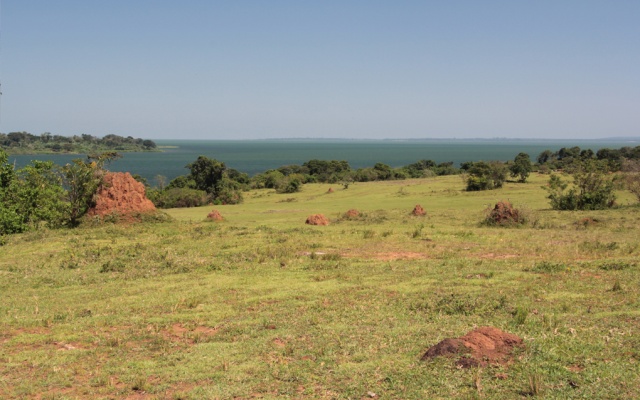The exhibition Opaque à elle-même. La Pologne et le postcolonialisme, 19 XI 2019 – 15 I 2020 (Opaque to Itself: Poland and Postcolonialism, 19 November 2019 – 15 January 2020), curated by Joanna Warsza, was presented in an unusual space in Paris: La Colonie, founded by the artist Kader Attia, has for many years been the hub of the postcolonial debate. The exhibition was not only an interesting attempt to confront Western European research into the colonial legacy with the universum of a semi-peripheral country – Poland, but also put under the spotlight the here-and-now of Eastern Europe.
Besides works by Janek Simon, Slavs and Tatars, and Agnieszka Polska, the exhibition was also pivoted on the project Paradise by Emma Wolukau-Wanambwya.1
1.
In November 2012, Emma Wolukau-Wanambwa, a British artist with Ugandan roots, accompanied a small group of former Polish refugees and their families, who were visiting Uganda for the commemorations of the history of the Kojja camp on Lake Victoria. The artist intended to make a documentary film. As we discover from her portfolio, however, the events that unfolded turned out to be stranger and more complex than she could have expected, rendering the documentary format impossible.2 Wolukau-Wanambwa writes,
This is partly to do with the nature of the story itself, and the way it challenges key aspects of the contemporary world order. But it also has to do with the complexity of the reunion itself, during which, through a series of acute oscillations, that world order was both reasserted and undermined, and the history of East Africa’s European refugees was both present and absent.
What, then, do we know about this history? In 1941 and 1942, 77 thousand Polish citizens who had been deported to Siberia join General Anders’s army. Simultaneously, the evacuation of 43 thousand civilians is taking place. Almost half of them end up in the refugee camps set up by the British in their African colonies – South Africa, Kenya, Tanganyika, and Uganda. The Uganda Protectorate has a special status in this context, as it is not a settlement colony. On a territory inhabited by barely two thousand Britons, seven thousand Polish refugees suddenly appear, mainly women, children, and the elderly. This is a threat to colonial order.
Two camps are set up, of which Kojja is one. The area is enclosed, and a special pass is required both to enter and to leave. The camp has a Polish manager, who reports to a British commander. Only the British authorities can grant permission to visit Kampala.
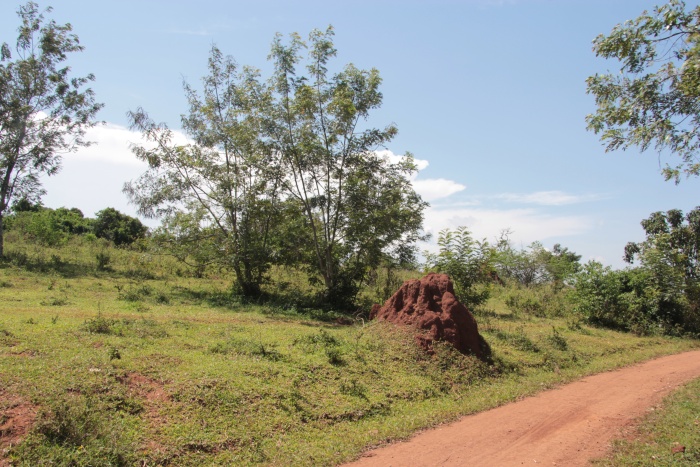
Emma Wolukau-Wanambwa, Raj (Paradise), 2012. Dzięki uprzejmości artystki.
From the beginning, this is crisis management; there is nothing to be seen there. When the British close the camp in 1952, its structures are completely dismantled. The Cold War continues, and the Polish refugees are resettled to Britain, Australia, or Canada. Only a very few return to Poland.
In the same year, in Kenya, an uprising breaks out, led by Mau Mau fighters (1952–1960). The British authorities suppress it brutally. When, in 2011, former Mau Mau members want to sue the British government for acts of torture, it is finally forced to admit that it had organized the systematic destruction of the archives before leaving the colony. The purpose of that operation was to prevent future court cases, denying the victims of colonialism a chance to seek justice. In Uganda, this operation was, paradoxically, codenamed Operation Legacy.
Emma Wolukau-Wanambwa calls her installation Paradise, devoted to the camp in Kojja, a meditation on erasure of this history. The work is part of the artist's broader project, under the working title Uganda in Black and White, focused on the examination of how late colonialism is being represented. In the words of the artist herself,
My aim has been to examine not only that which is made to ‘appear’ in these representations, but also to investigate the omissions, elisions and effacements that structure and produce them. Very importantly for me, examining these images and narratives of a ‘colonial utopias’ has also led me to consider the complex of strategies that colonial discourse employs in order to produce the colonised subject – the intertwining mechanisms of force and coercion, identification and disidentification, pleasure and displeasure whereby interpellation occurs.
2.
Paradise relies on fragmentation and mystery; its structure reflects our truncated access to the archives. The installation comprises a handful of photographs and a text – seemingly simple, but in fact full of ambiguity, contrasts, and unforeseen switching of the viewpoint.
The artist has placed herself in the position of narrator: The fact that when I get to Kojja there is almost nothing to see is by design.3 The “almost” means, that there is something to see, after all. But it is from what is not visible that we find out more about what Emma Wolukau-Wanambwa wants to tell us about.
The next paragraph starts with the word “inmates.” This is a shocking term when used to refer to the residents of a refugee camp. Nevertheless, this is the word used by the local Ugandans that the artist talks to. How does this word reflect the colonial reality? As Frantz Fanon wrote, a colony is a machine for segregation. Thus, the colonized Ugandans are, in a sense, also themselves “inmates.” We are faced with a concatenation of the systems of surveillance and control.4
Sixty years later old people weep openly in Warsaw as they describe the trauma of being made to leave this home. With this empathic switch in viewpoint, we gaze at the situation from the perspective of the refugees.
Later, we read, But it’s sex that the old men seem most keen to talk about today. We do not immediately realize that the narrative has returned to Uganda: Specifically, the sex that was had in secret by Polish women and local men. (Of intimacies between Polish men and local women, I note, they make no comment.) Colonial order is based on unequal distribution of access to women – to undermine this order is at all times a small victory to those who live their lives being dominated.
We reach the heart of the narrative.
The camp commandant maintained, they say, that there were never any illegitimate children. But it was common knowledge, they tell me, that whenever a Polish woman fell pregnant by a local man, their baby was killed at birth. Its body discarded as medical waste.
“Those women, they were prostitutes.” Kasule smiles, his sightless eyes twinkling, his grandchildren crowding round, staring and eavesdropping with all their might.
“Prostitutes.” Also how these women were described by regional director of refugees, and the camp commandant – he who remanded two women from Kojja on this very charge to the penitentiary at Makindu.
It turns out that the local men have adopted the official term used to discipline women. Women remained the trophy in male rivalry. Kasule’s grandchildren look on and listen; they are the offspring of the man telling the story. Witnesses to the conversation, they soak up the intergenerational knowledge, creating their own post-memory, a myth. The story crystallizes in those few sentences, in its dark heart that passes our understanding.
I think about this story as I take Kasule’s picture, a picture he will most likely never see. And I think about it again later as I stand looking at the anthills. And the lake.
“I think about this story,” writes Emma Wolukau-Wanambwa, but we will not find out what her thoughts are. Kasule will probably never get to see his photograph – nor will we. Paradise repeatedly denies us access.
The landscape that we see in photographs poses more questions. What we have before us is an ordinary stretch of the Ugandan savannah. I saw it many years ago. It didn’t seem especially uninhabited to me; people and animals use it in different ways. Yet the story I have just read makes me feel that the place I am looking at has been deserted. This is a Paradise, from which people have been expelled.
But was this not the underlying notion behind colonialism that this was exactly how territories beyond Europe were – empty, and demanding a European presence? Among the “colonial utopias” that Emma Wolukau-Wanambwa is interested in is the British idea of setting up the state of Israel on the shores of Lake Victoria. Are we thus looking at a space that is empty or full? And if it is inhabited – then by whom or what? We are drawn into a maelstrom of presence / absence.
What do we know, however, about the story we have been told? Is it a rumor? Legend? Fact? What we are left with are two key words: “medical waste” and “prostitute.”
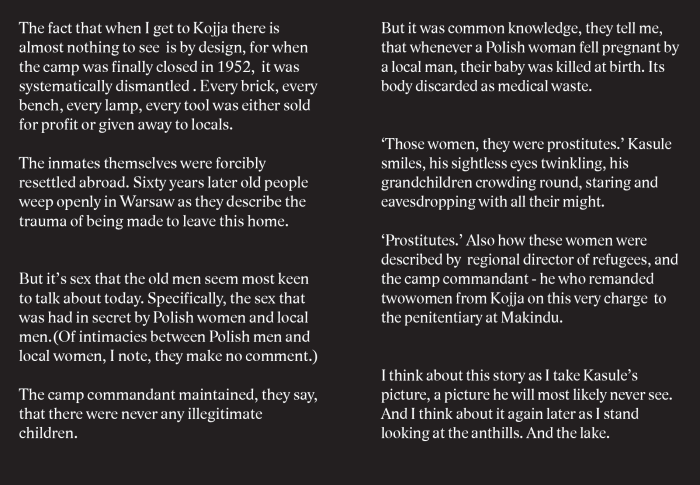
Emma Wolukau-Wanambwa, Raj (Paradise), 2012. Dzięki uprzejmości artystki.
3.
The history of governance of colonial sexuality has a dynamic of its own. The first period of colonialist expansion, up to the 17th century, was a time of fascination with the carnality of “exotic” people. The East India Company, founded in 1600, urges its employees to have relations with Indian women. Such liaisons will help them to better understand the local social structures and rein them into colonial ventures. The conquest employs a patriarchal, erotic metaphor of penetration of the subservient, virginal lands. The sexual appropriation of the local women is a sign of taking the land into possession, the final seal of power exerted over the men.
In the mid-19th century, the situation changes. “Scientific racism” generates the fear of the “downfall of the race.” Mixed-race children are now viewed as a problem, both practical and ideological. What status should they have so as not to disturb the strict divide that has been created between the colonizers and the colonized?
Meanwhile, the “exotic” woman has become the conduit for the same fears as another mythical figure – the cannibal. Both stand for the threat to the colonizer of being devoured by the colonized society. Colonial novels abound with young officers who die of fever in the arms of an African lover. Children from these relations don’t live long – they are sickly or asocial, as if their fate has to prove their systemic impossibility.
In 1909, a circular is issued in British African colonies, prohibiting the taking of a native concubine. This is supposed to boost segregation and strengthen colonial power. As the economic situation gradually improves and the fear of revolt wanes, the circular is slowly withdrawn. In 1945, however, the colonial administration is thrown into a panic. Four officers in the Gold Coast (today’s Ghana) want to officially marry their local partners, with whom they apparently have children. Their intentions are interpreted as an effect of insanity and lack of access to European women. It is argued that their African wives will be an insult to the European wives of other officers.
To put some distance between the British colonizers and African women, in some regions, e.g. Rhodesia, there is a degree of tolerance for white prostitutes, even if they also accept African clients.
Poland has no overseas colonies. Are the Polish men – and women – whom the maelstrom of history had tossed into Africa, less racist and prone to colonial ideology than the British? There is nothing to indicate that. Poles read Verne and Kipling; Polish culture soaks up and reproduces colonial ideology. It feels itself a part of the imperialist white civilization.
When in 1918 Poland regains its independent state, the country has already absorbed all the blueprints of overseas colonialism. The Polish Maritime and Colonial League, which in the exhibition Opaque à elle-même is the theme of the work The Sea by Janek Simon, rolls out its plans for Polish colonies: in South America, Mozambique, and Madagascar. Before the outbreak of World War II, the League has one million members and is popular not only with adults but also with children.
4.
Paradise was first exhibited in 2012, during the first Festival of Contemporary Art in Kampala. The installation was set up in a shipping container. While in Europe this brings associations with African refugees crossing the Mediterranean, the perception differs in Uganda – a country that has long accepted refugees from the Congo and South Sudan. Today, beside 42 million native Ugandans, there are some million more recent arrivals, and the manner in which they have been integrated is often held up as exemplary. Thus in Uganda, Paradise resonated in a unique way, while also reminding Ugandans of the little-known history of the camps for refugees from Europe.
The topic has already been researched by Ugandan historians, and the paper by Samwiri Lwanga-Lunyiigo from the Makerere University in Kampala5 is very informative. On the basis of the surviving part of the archive, he mentions, among other things, anti-Semitism among Polish refugees and a plan to create a separate camp for Jews. This plan fails, because it is the Jews who have the highest qualifications for “clerical and other duties of camp maintenance.” However, as Lwanga-Lunyiigo points out, the Poles in Uganda do not display racism. In October 1942, the Poles are described in the Luganda newspaper Matalisi as well-built and not prone to discrimination. Their language sounds nice but is very difficult to write down. The Poles like Uganda and intend to stay there.
As Lwanga-Lunyiigo points out, only 20% of the refugees in the camp are male. As for women, the Chief Secretary of the Uganda Protectorate writes,
It is our policy to reduce occasions on which Africans and Poles come into contact to a minimum, adding, however: At the same time we must recognize that there are large numbers of women who have been denied male society for a considerable period and that such circumstances form a suitable ground for the development of illicit relations.
Earlier, the Kenyan Director in charge of Refugee Affairs had requested that there be no prostitutes among the refugee women. Now he writes that there are cases of sexual misconduct among the Greek women, but not the Polish ones. From Tanganyika there arrives information that the refugee women have relations with Indian men.
In February 1944 the commandant of the Nyabyeya camp in Uganda expels two women who have become involved with the African policemen who patrol the camp and stand sentry. He writes:
Not only do cases of this kind lead to a bad reputation being undeservedly given to the Polish people as a whole… but in addition, a bad effect is created among the Africans locally and I cannot help feeling sympathy with a young African Policeman whose character is ruined by the experienced importunities of a degraded street walker from some Polish town.
At the commandant’s behest, both women find themselves in the prison for Poles in Makindu. The medics diagnose them as “feeble minded” and “sexual perverts,” since they were found in the sleeping quarters of the African policemen from the Mobile Propaganda Unit. The commandant urges that the women should have no further contacts with Africans of any social class, as they have lowered the status of Europeans. In his opinion, drastic step should be taken to prevent a recurrence.
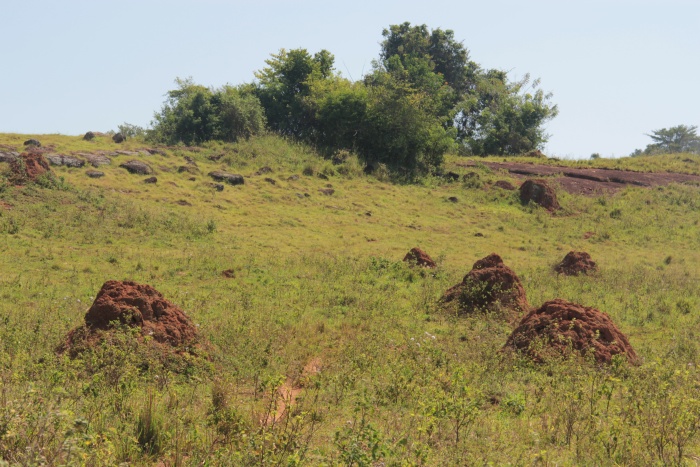
Emma Wolukau-Wanambwa, Raj (Paradise), 2012. Dzięki uprzejmości artystki.
In 1945, he writes to his superiors: I should be grateful if I could receive a supply of barbed wire which may now be available as the war is over. This will assist me in segregating mental cases.
In his paper, Samwiri Lwanga-Lunyiigo indicates clearly where his own sympathies lie. He writes about the lonely women who embark on “illicit” relationships with men, whom they see as human beings and who give them the friendship and warmth that they long for. Unfortunately, the desire for human contact and warmth was interpreted by the British authorities as prostitution, and severely punished. He thinks that Polish blood still flows in the veins of some Ugandans, as a consequence of such “illicit” liaisons, especially between Ugandan women and Polish men.
Lwanga-Lunyiigo is convinced that these surreptitious Polish–Ugandan contacts brought precisely the results that the British had dreaded: There was a racist colonial regime in Entebbe who employed psychiatry to isolate the aberrant Polish. To the Africans this relationship with white people to some extent demystified whiteness and gave many of them the courage to demand their lost freedom.
5.
On the Polish side, since 1989, the memory of the African camps has been looked after by the many associations of former Polish deportees to Siberia. It is also one of the research subjects of the Center for the Documentation of Deportations, Expulsions and Resettlement at the Pedagogical University in Krakow. Its creators wanted it to be, to some extent, a Polish response to the Centre against Expulsions, established in Berlin.
How should a balance be ensured between research objectives and the expectations of the surviving Siberian deportees and their families? How can one satisfy their need for solemn commemoration without falling into the trap of martyrology – which tends to focus on the suffering to the exclusion of any other aspects or points of view? How can one avoid succumbing to the temptation to consider one’s own suffering as exceptional? And how should one include in this history the narratives that have been generally been passed by in silence? As part of the general history of sexual oppression? Or sexual work? And, finally, how to include the intimate paths of the sexuality that allowed the people suffering oppression to feel alive?
The Centre has in its archives numerous testimonies about the camps in Africa. Colonialism has not, however, been thematized, and Ugandans only rarely make an appearance. Having spent two days on internet searches, I bounce off the smooth façade of this history: the Siberian hell versus the African paradise. Perhaps, somewhere, in the folds, on the margins, there lurk the threads that Samwiri Lwanga-Lunyiigo and Emma Wolukau-Wanambwa have taken up? In the majority of the few-minutes long reminiscences posted online by the Centre for Documentation of Deportations, Expulsions and Resettlement, the former refugees talk about the everyday life, school and youth organizations – they were only children at the time. In the camp there was a theater, cinema and hospital staffed by Polish medical personnel; I also learn that there was a Polish ward at the European Hospital in Kampala.
What emerges is a story about the ability to adapt and about self-help, about building a (Polish) life from scratch on a tropical peninsula. There are echoes of Robinson Crusoe’s adventure – complete with its colonial overtones. In his documentary My Daddy Was a Cavalryman (2006), the Polish-Kenyan film director Jakub Barua touched upon the complexity of these relations as well as their shady side. His narrator is Janina Roche, who stayed on in Kenya, strangely suspended between the local social strata, and not a part of any community.
In 2017, the health center named after the Polish Siberians was built in Kojja as a gift from Poland to the residents of Kojja. This is a beautiful gesture of gratitude. Yet at the same time, has it not enabled Poles to play on an essentially colonial nostalgia, which makes Kojja, in the words of one of the refugees, “a piece of our Polish land in Uganda”? How does one tell where love ends and a symbolic taking over possession begins?
6.
Taking control of women’s bodies is a strategic part of the colonial mechanics. In colonial Uganda, a series of sinister categories springs up: prostitute – mentally retarded – sexual deviant – psychiatric asylum – prison. We are in the thick of the repression of women’s sexuality and reproductive rights, as sexual constructs have met racial ones.
Crossing the colonial barrier is taboo for European women, since in a patriarchy, the sexual act is equated with taking mastery of the woman. An act that goes against the tide of colonial hegemony undermines its very cornerstone. Such a woman must be devalued and classed as beyond the pale.
She is thus a “prostitute” and their child “medical waste.” The narrative about Kojja dovetails with the history of eugenics, which in different parts of the world has been deployed against the lower classes and different “races.” One example is the French island of Réunion, in the Indian Ocean, where, until as late as 1970, the poor women of color were not only sterilized but also subjected to pregnancy terminations without their knowledge and against their will.
Paradise gets right to the heart of the problem. The term “medical waste” is devastating. It means that the matter in question is human, yet it is not the body of a dead person. And if so, then then this could not have been a person when still alive. To take such a life away is – thus – not a crime that one would need to conceal. It is a medical procedure.
As Hannah Arendt notes in The Origins of Totalitarianism, what takes place in colonies is dehumanization. The “savages” don’t seem human. When Europeans commit slaughter, they do not have a sense that they have committed murder. Another underlying rationale for what Arendt has termed the “colonial massacre” is colonial bureaucracy. It enables everybody to divest themselves of responsibility. Thus firstly, no massacre has taken place. Secondly, nobody is individually culpable.
Joseph Conrad’s The Heart of Darkness deems violence to be inherent in the barbarian human nature that lurks inside each of us beneath a thin veneer of civilization. Emma Wolukau-Wanambwa has reversed the narrative. In Paradise, violence, expressed through the category “medical waste,” turns out to be part of what is commonly referred to as “civilization.”
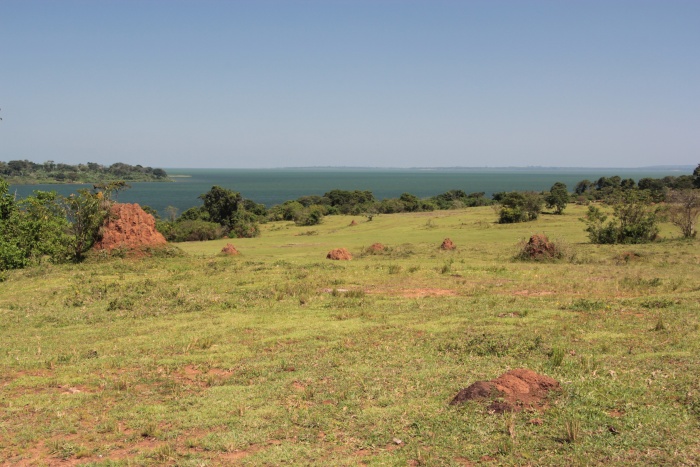
Emma Wolukau-Wanambwa, Raj (Paradise), 2012. Dzięki uprzejmości artystki.
7.
The text we are reading is deceptively simple but tense. So tense that in translation it breaks and the hidden language triggers show through.
“Kasule smiles, his grandchildren crowding round…” For the verb “to crowd”, the French dictionary offers “se presser”. But, for some reason, in the translation in La Colonie there appears “s’entasser,” a word commonly used to mean the piling up of objects. In the translation, a note of humor, exaggeration and excess has appeared, absent from the original.
In the Polish translation, the verb “to crowd” has been rendered as “roić się,” which – when used literally, in relation to insects, means “to swarm,” whereas in relation to human beings serves to emphasize their large numbers and uncontrolled movement, with negative connotations. In 2015, the British Prime Minister David Cameron met a barrage of criticism when he called migrants “a swarm of people coming across the Mediterranean.” It was pointed out to him that this was a derogatory term when used in reference to human beings, rather than insects. There was widespread condemnation of the use of such language to dehumanize and introduce disquieting social divisions.
In his Letters from Africa, Henryk Sienkiewicz, referring to Constantinople, comments, “This Asian swarming is somewhat reminiscent of swarming vermin.” And in the novel Pharaoh by Bolesław Prus, his Ramses complains about the Jews who “swarm at night like rats through the filthiest districts.”
The work by Emma Wolukau-Wanambwa has activated a secondary effect. The fact that in the same place something strange has happened both with the Polish and French translation, faltering and breaking down, shows that we have perhaps discovered the pivot of the text – its hidden trapdoor. The neurotic European imagination has kicked in. Here, Kasule and his grandchildren are no longer an ordinary family – they have become a representation of the uncontrollable African demographic, a representation of the forever multiplying menace of the “Other”.
We find the story told by Kasule profoundly shocking. Nevertheless, the linguistic mechanisms that lurk in our respective European languages reveal that – despite our shock and compassion, despite our faith in the ideals of equality – we, as users of European languages, remain participants in the same excluding culture. Sometimes, a moment’s inattention is enough for it to speak, from our own lips. This is a culture that still deploys the dehumanizing mechanisms that have evolved throughout centuries, depriving some individuals of the status of human being and the right to be alive – and it has continued to do so, incessantly, and in many different ways. In the service of the new forms of necropolitics, the matrices for the construction of “Otherness” that serves to exclude some people from the moral community have been taking ever-new and changing shapes. The work of standing up to such matrices and refusing to play the game – let’s call it the work of “dis-Othering” – is never done. But if we don’t persevere, how can we even imagine any possibility of change?
Such is the fruit of the knowledge of good and evil that grows out of Paradise.
Translated from Polish by Anda MacBride
BIO
Olga Stanisławska was born in Warsaw. She is a writer, journalist, essayist, curator. She was awarded the Koscielski Foundation Award for her book De Gaulle Roundabout (2001). She co-curated the exhibitions Nostalgia made body. Africa in Kazimierz Zagórski's photography (Galerie Zachęta, Warsaw, 2005); and New Region of the World (Bunkier Sztuki Gallery, Krakow, 2017). She also co-authored a documentary on Muslims in France for TVP (2007, with Borys Lankosz). She lives in Paris.
*Cover photo: Emma Wolukau-Wanambwa, Paradise, 2012. Courtesy of the artist.
[1] In the Polish context the work was first shown in the exhibition Everything is Getting Better: Unknown Knowns of Polish (Post)Colonialism, curated by Joanna Warsza in Savvy Contemporary in Berlin 2017). In Poland, it was first shown in the exhibition Women, Independence and National Discourse in the Museum of Modern Art in Warsaw (curator Magda Lipska, 2018–2019).
[2] Emma Wolukau-Wanambwa, Public Portfolio, Uganda in Black and White, http://khib.azurewebsites.net/media/3226969/ew_portfolio_public_141126sm.pdf, [accessed: 14 January 2020].
[3] From the Polish translation Women, Independence and National Discourse in the Museum of Modern Art in Warsaw.
[4] Emma Wolukau-Wanambwa is also interested in a set of 80 photographs, commissioned by the British government to be taken in Ugandan prisons for propaganda. Why were they taken? Why had they not been destroyed? Why is it that, today, photographs from prisons constitute the majority of the visual exhibits in the British National Archive for the Uganda Protectorate, which for over 80 years was under British rule?
[5] Samwiri Lwanga-Lunyiigo, Uganda's long connection with the problem of refugees: from the Polish refugees of World War II to the present. From his lecture given at the Uganda and Refugee Problems, 20 December 1993, Makerere University, http://repository.forcedmigration.org/show_metadata.jsp?pid=fmo:1145, [accessed: 10 December 2019].



